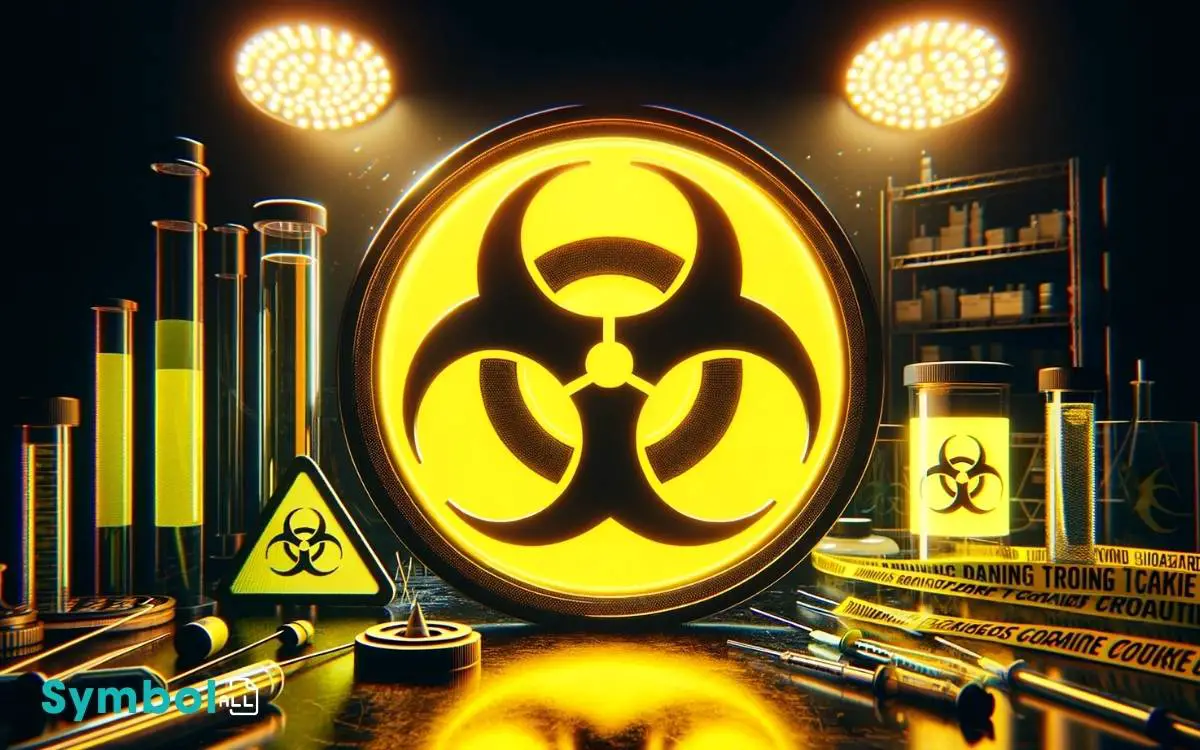What Color Is the Biohazard Symbol? Orange-Red Color!
The biohazard symbol is universally recognized in a vital orange-red color. This shade, selected for its noticeable visibility, signals danger and demands caution.
When you see this color, it’s crafted to catch your eye and alert you to the presence of hazardous biological materials. The human eye is particularly responsive to this hue, ensuring the symbol grabs attention immediately.
This choice in color transcends language and cultural barriers, effectively communicating the need for safety across the globe. Bright colors like this are essential in maintaining adherence to safety protocols.
Uncover the depth behind its design and significance to understand why this color was chosen.

Key Takeaways
Origins of the Biohazard Symbol
The biohazard symbol, universally recognized today, was ingeniously crafted in 1966 by a team at the Dow Chemical Company, aiming to provide a clear, memorable indicator of hazardous biological substances.
You’ll find it interesting that this symbol wasn’t the result of a random creative burst. Instead, it was meticulously designed through a rigorous selection process.
The team’s goal was to devise a symbol that didn’t resemble any existing signage, ensuring it wouldn’t be confused with other types of hazards.
This symbol needed to be easily recognizable and understandable across global barriers, transcending language and cultural differences.
Its creation marked a significant advancement in safety protocol, emphasizing the importance of effective communication in preventing accidental exposure to biohazards.
Understanding Color Psychology
Delving into color psychology, it’s important to understand how specific hues can greatly impact human perception and behavior. Colors aren’t just visual elements; they convey emotions, messages, and can even influence decision-making and psychological reactions.
For example, red often denotes danger or urgency, triggering a heightened sense of alertness. In contrast, blue can evoke feelings of calmness and trustworthiness.
Understanding these psychological effects is vital when designing symbols or warnings meant to communicate specific messages or evoke particular responses.
It’s not just about the aesthetic appeal; it’s about choosing colors that accurately convey the intended warning or information, ensuring that the message is universally understood and elicits the correct response.
This knowledge is foundational when considering the significance of color choices in safety and hazard symbols.
The Standard Biohazard Color
Expanding on the understanding of color psychology, it’s vital to highlight that the standard color for the biohazard symbol is a vibrant orange-red, selected specifically for its capacity to grab attention and indicate caution. This choice isn’t random.
The human eye is highly sensitive to this hue, ensuring that the symbol stands out, even from a distance or in a cluttered environment.
This effectiveness in visibility is paramount for safety, as it immediately alerts individuals to the presence of potentially dangerous biological materials.
The color’s intensity isn’t just about visibility; it’s a universal signal for danger, leveraging innate human reactions to color cues for immediate recognition and response.
This strategic use of orange-red underscores the importance of color in conveying critical safety information.
Significance of Bright Colors
Bright colors, including the vibrant orange-red of the biohazard symbol, serve a pivotal function in safety and warning systems by instantly drawing your attention and signaling caution.
These hues aren’t chosen arbitrarily. They’re strategically selected for their psychological impact and visibility.
Bright colors, especially those on the warmer end of the spectrum, are more likely to catch your eye, even from a distance or in a cluttered environment. This immediate recognition is vital in situations where a split-second decision could mean the difference between safety and danger.
The unmistakable presence of a biohazard symbol, thus, isn’t just a matter of design preference; it’s a carefully considered choice that prioritizes human psychology and physiological response to maximize visibility and adherence to safety protocols.
Variations in Different Contexts
While the vibrant orange-red hue of the biohazard symbol is universally recognized for its warning capability, its appearance can vary greatly across different contexts to accommodate specific environmental and regulatory requirements.
In healthcare settings, you’ll often find the symbol against a bright background for immediate visibility, sometimes flanked by additional cautionary text to underscore the risk.
In laboratories, the symbol might be adapted to fit on various containers, from large waste bins to small vials, necessitating variations in size without compromising the design’s integrity.
Regulatory bodies in different countries may mandate slight alterations in color or design for consistency with other hazard symbols, ensuring that the symbol’s critical message transcends language barriers.
These adjustments guarantee the symbol remains a potent alert, regardless of where or how it’s displayed.
Contrast and Visibility
You must acknowledge the vital role bright colors play in ensuring a biohazard symbol stands out, especially in critical situations.
These vibrant hues are key to enhancing symbol recognition, allowing for quick identification by individuals.
Additionally, their high visibility is indispensable during emergencies, ensuring safety protocols are promptly followed.
Importance of Bright Colors
High-contrast colors greatly enhance the visibility and recognition of safety symbols, guaranteeing they quickly catch your attention in any environment.
Bright colors play a vital role in this situation. They’re not just arbitrary choices but are selected based on their ability to stand out against various backgrounds.
This is essential in emergency situations where rapid identification can mean the difference between safety and danger. Bright colors like the vivid orange or fluorescent green often used in safety signs, including the biohazard symbol, are specifically chosen for their high visibility.
They guarantee that the symbols are immediately noticeable, even from a distance or in peripheral vision, making them effective in conveying warnings and critical information without the need for close inspection.
Enhancing Symbol Recognition
To effectively enhance symbol recognition, contrast and visibility must be meticulously optimized, ensuring that safety symbols are immediately discernible in any setting. High contrast between the symbol and its background is essential.
This isn’t just about selecting bright colors, but about choosing hues that stand out against their surroundings.
For instance, a bright orange biohazard symbol on a white background offers stark contrast, making it hard to miss.
Additionally, the size and placement of the symbol contribute greatly to visibility. It should be large enough to be seen from a distance and positioned at eye level whenever possible.
These strategies guarantee that the symbol catches the eye quickly, aiding in rapid identification and response without encroaching on the domain of emergency visibility specifics.
Visibility in Emergencies
In emergency situations, visibility becomes a critical factor, demanding that symbols not only stand out but are instantly recognizable to guarantee swift and appropriate responses.
The color of the biohazard symbol is specifically chosen for its high visibility and contrast against most backgrounds, ensuring it catches your eye immediately.
To understand its effectiveness in emergencies, consider the following aspects:
- Contrast: The bright orange-red color contrasts sharply with the typical colors of natural and man-made environments, making it highly noticeable.
- Universality: Its distinct color and shape are universally recognized, reducing confusion and aiding in quick identification.
- Adaptability: The symbol can be easily adapted to different materials and surfaces, maintaining its visibility across various contexts and lighting conditions.
These factors ensure that in critical moments, you’re able to identify potential biohazards quickly, enabling rapid decision-making and action.
Global Standards and Regulations
You’ll find that international color codes play a vital role in ensuring the biohazard symbol is universally recognized.
Regulation compliance across different countries necessitates a deep understanding of safety signage evolution to maintain the symbol’s effectiveness.
This ensures that the symbol adheres to global standards, enhancing safety and awareness wherever it’s displayed.
International Color Codes
Understanding global standards and regulations, it’s important to recognize that international color codes play a significant role in maintaining safety and uniformity across various industries.
These colors aren’t selected at random; they’re part of a carefully designed system to convey specific hazards and information quickly and universally.
- Red signifies danger, often associated with fire hazards or prohibitive actions.
- Yellow indicates caution, marking physical hazards such as slipping or tripping.
- Green symbolizes safety, directing towards emergency exits or first aid equipment.
These color assignments aren’t simply recommendations but are embedded within international safety protocols to guarantee a universal understanding, regardless of language barriers.
This strategic use of color aids in preventing accidents and ensuring a safer environment for everyone involved.
Regulation Compliance
Adhering to global standards and regulations guarantees that industries worldwide maintain a high level of safety and compliance.
You’ll find that these regulations specify the use, design, and placement of biohazard symbols to mitigate risks associated with the handling of hazardous biological materials.
They guarantee uniformity, meaning regardless of where you’re in the world, the biohazard symbol communicates the same message.
For your operations to stay compliant, it’s vital to keep abreast of updates from authoritative bodies like the World Health Organization (WHO) and the Occupational Safety and Health Administration (OSHA) in the United States.
These organizations set forth guidelines that dictate how and where the biohazard symbol should be displayed, promoting a safe environment for workers and the public alike. Compliance isn’t just a legal obligation; it’s a dedication to safety and health.
Safety Signage Evolution
While adhering to global standards is a foundation of safety, the development of safety signage, including the biohazard symbol, reflects ongoing improvements in public health protection.
This progression can be attributed to several factors:
- International Consensus: Worldwide agreements have led to the standardization of safety symbols, making them universally recognizable.
- Technological Advancements: Enhanced manufacturing and design technologies allow for more durable and visually striking signs.
- Research and Feedback: Continuous input from health and safety professionals ensures that signage remains effective in conveying hazards.
This analytical approach guarantees you’re not just compliant, but also contributing to a safer environment.
By understanding the significance behind these changes, you’re better prepared to implement and respect the symbols designed to protect you and those around you.
Color Durability Over Time
The durability of the biohazard symbol‘s color fades over time due to exposure to environmental factors.
Sunlight, particularly its UV rays, plays a significant role in this degradation process, breaking down the color pigments, resulting in a less vibrant and potentially less recognizable symbol.
Additionally, harsh weather conditions, including rain, snow, and extreme temperatures, contribute to the fading and wear of the symbol’s color.
Chemical exposure, a common occurrence in environments where biohazard symbols are necessary, can also accelerate color degradation.
It’s crucial to take into account these factors when selecting materials and pigments for the biohazard symbol to guarantee longevity and maintain its critical function in safety and hazard communication.
Impact on Public Perception
Understanding how the fading of the biohazard symbol’s color affects public perception is crucial, as it can significantly reduce its visibility and the immediate recognition of potential danger.
When you’re aware of the elements that influence how people perceive the biohazard symbol, you can recognize the importance of maintaining its distinct coloration.
Here are three critical points:
- Visibility: As the color fades, the symbol becomes less noticeable, potentially leading to overlooked hazards.
- Recognition: Bright, distinct colors guarantee immediate recognition; fading compromises this instant identification.
- Response: A clearly visible biohazard symbol prompts a quicker safety response from the public and professionals alike.
These factors combine to demonstrate why preserving the vibrancy of the biohazard symbol’s color is crucial for public safety and awareness.
Safety and Warning Signage
Safety and warning signage, including the biohazard symbol, play a vital role in mitigating risks by alerting you to potential dangers in your immediate environment.
These signs are designed to grab your attention swiftly, using specific colors and symbols universally recognized for their meanings.
The biohazard symbol, with its distinctive shape and color, specifically warns you of biological substances that pose a threat to human health or the environment. It’s not merely about recognizing the symbol; understanding its implications is essential.
Educational and Training Uses
You’ll find that the color of the biohazard symbol plays a critical role in enhancing safety protocols, particularly in how it’s integrated into training materials. This strategic use of color ensures that the symbol is immediately recognizable and associated with potential biological risks, reinforcing a swift response when needed. Incorporating OSHA symbols and color designations into training materials further standardizes safety practices, making it easier for individuals to identify hazards across various environments. As a result, employees are better equipped to follow established protocols, reducing the likelihood of accidental exposure or mishandling.
Its distinct hue guarantees it stands out in training simulations, aiding in the development of more effective emergency response exercises.
This visibility is key in designing materials that not only inform but also engage participants in a meaningful way.
Safety Protocol Enhancement
Implementing enhanced safety protocols through educational and training initiatives greatly reduces risks in environments exposed to biohazards.
By focusing on these areas, you’re not only guaranteeing compliance with regulations but also fostering a culture of safety and awareness.
Here are three critical steps to enhance safety protocols:
- Identify Specific Risks: Understand the unique biohazards present and tailor your training to address these specific challenges.
- Regular Drills and Simulations: Conducting regular practice drills ensures that response procedures become second nature.
- Continuous Feedback Loop: Implement a system for feedback and continuous improvement of safety protocols, allowing for adjustments based on real-world application and evolving threats.
Training Material Design
Effectively designing training materials is vital for enhancing the understanding and application of safety protocols in biohazardous environments.
You must integrate the recognizable biohazard symbol, with its distinct color, into all educational resources to guarantee immediate recognition and response.
The materials shouldn’t only convey critical information but also engage learners through varied formats—visual, auditory, and interactive elements are essential to retention.
Clear, concise language tailored to the audience‘s level of expertise is pivotal. Diagrams and real-life scenarios can help bridge the gap between theoretical knowledge and practical application.
Simulation Exercises Development
To maximize the effectiveness of biohazard safety training, it’s crucial to integrate simulation exercises that closely resemble real-life scenarios.
These simulations should be crafted to challenge and engage participants, guaranteeing they’re well-prepared for actual biohazard incidents.
Consider the following key components when developing these exercises:
- Realism: Utilize realistic settings and materials to replicate biohazard scenarios accurately. This encompasses using imitation biohazardous substances and recreating workplace environments.
- Interactivity: Make sure the exercises demand active participation, decision-making, and problem-solving. This involvement fosters deeper learning and retention.
- Feedback: Offer immediate, constructive feedback during and after the simulation. This assists learners in comprehending their performance and areas for improvement, reinforcing the training’s key points.
Future Trends in Safety Symbols
Exploring future trends in safety symbols, it’s crucial to anticipate changes driven by technological advancements and global standardization efforts.
You’ll see symbols becoming more intuitive, incorporating universally recognizable elements to transcend language barriers.
Expect the integration of digital elements, like QR codes, offering instant access to detailed safety information or instructional videos. This evolution aligns with the growing reliance on smartphones and digital devices in daily life.
Global standardization will streamline safety symbols, making them consistent across borders. This move enhances comprehension, especially in multinational settings, ensuring everyone understands the risks and precautions regardless of their native language or country of origin.
As you navigate these changes, staying informed about the latest developments in safety symbols will become increasingly important for maintaining a safe and compliant environment.
Conclusion
In summary, the biohazard symbol, adorned in the universally alarming shade of bright orange-red, serves as humanity’s neon stop sign against biological threats.
Its color isn’t just a random choice; it’s a calculated decision steeped in psychology to grab your attention quicker than a cheetah spots its prey.
As it continues to evolve across various contexts, its impact on public safety and awareness remains monumental. This symbol, a beacon of caution, educates and warns, ensuring we tread carefully in a world brimming with unseen dangers.






